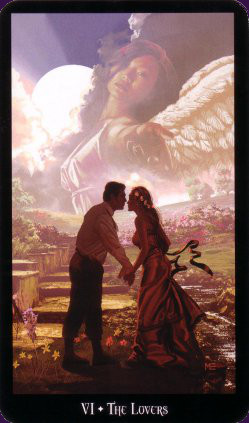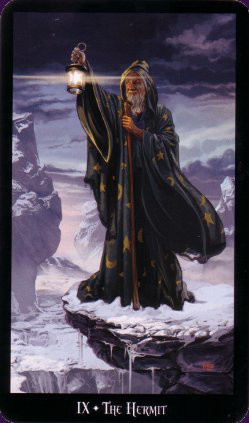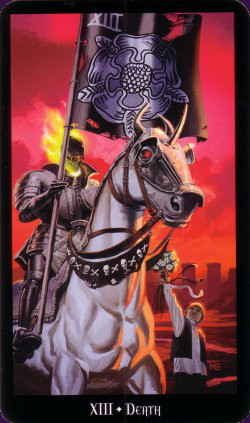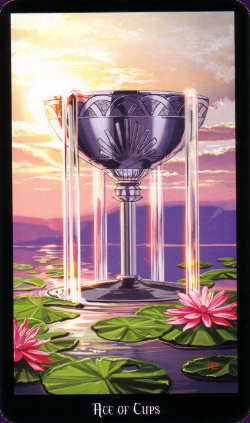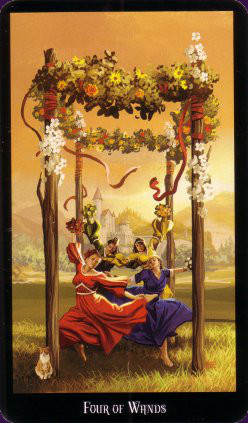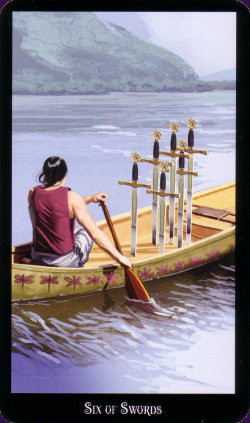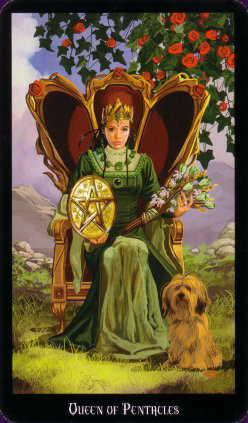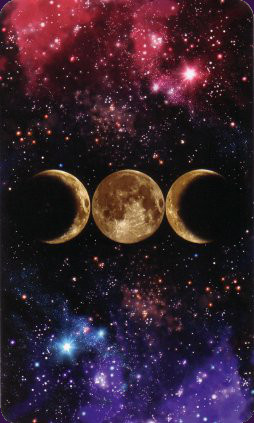Witches Tarot Deck Review
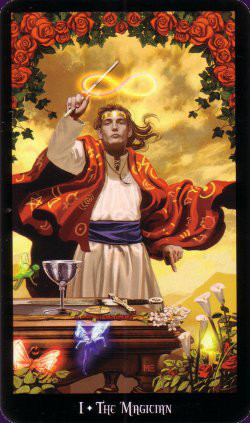
The Witches Tarot overlays natural Pagan symbols on the traditional tarot structure to create a visually attractive deck. Created by practicing garden Witch and Llewellyn author, Ellen Dugan (who also wrote the excellent companion book) and digitally illustrated by Mark Evans.
Deck Type: Tarot Deck Cards: 78
Creators: Ellen Dugan, Mark Evans
Publisher: Llewellyn 2012
Retailers
See Price at Amazon.comSee Price at Amazon.co.uk
See Price at Amazon.ca
Witches Tarot Review by Eeviee
When I first saw the images from the Major Arcana on the Witches Tarot website, I thought I would really love this deck! The deck is nice overall, but certainly did not meet or exceed my expectations. Perhaps my expectations were too high, expecting much more Wiccan/Pagan insights... Once I got through the Companion Book, however, I was able to appreciate the deck for what it was, rather than what I hoped it to be.
The way the deck was advertised and marketed made me think it would deviate much more from the RWS tradition than it has. I thought it would be much more 'witchy' and have many more modes of symbolism not usually found amongst RWS-based decks. The claim that it has "instantly recognizable Pagan symbols" is a bit much, however, as most of the symbols aren't particularly Pagan. As far as the Pagan symbolism goes, Dugan & Evans pay much more attention to the plants and sometimes animal 'companions' throughout the deck. The flowers, plants, and trees are more diverse than the RWS standard of lilies and roses and generic non-specific forestry. Dugan has thoughtfully chosen which plants/herbs/flowers and stones to symbolize or emphasize each cards meanings. In some cards Dugan and Evans use animals/birds/mythical creatures that may deviate or be an addition to the RWS-norm. These, too, are added based on Pagan teachings.
The most obvious deviation from the RWS comes from her renaming of the Major Arcana: V – The Hierophant has been named The High Priest (which in some Marseille-style decks, it was previously called), X- The Wheel of Fortune becomes The Wheel of the Year, XV – The Devil is renamed The Shadow Side, and XX – Judgment is called Karma. The High Priest/Hierophant isn’t really that much of a stretch and I tend to define the Hierophant as such, personally. The Wheel of Fortune/the Year is kind of a common stretch in meaning, as Fortune tends to indicate chance or luck, while the Year is cyclical and predictable. -I’m not quite so sure about this re-naming, however popular it is within Pagan themed decks. The Devil/Shadow Side I find to be a particularly effective re-naming, as the Devil is a purely Christian symbol, and certainly confusing and sometimes scary to Querants. I am also fond of Dugan’s adjustment to Judgement to Karma, as they are both very similar in meaning, and Judgement has a bit of a patriarchal and Christian undertone to me. Dugan has mentioned an article on Llewellyn ('Every Card Tells a Story: The Story Behind the Cards for Witches Tarot' by Ellen Dugan) that XIX - The Sun portrays her son Kraig as a child.
The Cups suit has some featuring of mermaids. Though, not the Undines of the Element of Water. Any mermaid depicted is a beautiful woman, once top-naked but done tastefully. No "non-pretty" mermaids or mermen, however, make an appearance. Dugan includes seashells on her silver chalices, and they come up as decorations throughout the suit. Dolphins appear in the 8 of Cups and the King of Cups; Starfish appear in the 8 of Cups; in the Page a Fish appears out of her chalice. Pretty much every character in the suit is wearing blue, and most cards depict a scene with some kind of water; ponds, rivers, lakes, waterfalls, and the ocean provide backdrops for the suit. In the article 'Every Card Tells a Story...' Dugan mentions that her husband is the man appearing in the King of Cups, and that the Knight of Cups is her son Kraig. She also states that the 3 and 9 of Cups feature members of her coven, and that her children Kyle and Erin appear in the 6 of Cups in their youngster days.
The Swords suit shows faeries amongst the scenes in the 2, 3, 5 and Queen of Cups. The faeries aren't detailed or striking and are probably the most un-realistic aspects of the deck. Also, they are all done in monochrome, a single colour with various shades that are usually bright and glowing. These faeries aren't quite the Sylphs of the Element of Air. The birds appearing in this suit are what ties it together. The Ace, Page, Knight and King features hawks; the 4 and 7 of Cups utilizes peacock feathers; the 5 and 6 features dragonflies; the 10 of Cups shows a perched owl; and the Queen has songbirds built into her throne, and blue-jays surrounding her. The backgrounds in the suit of Swords usually have mountains or hills, and occasionally barren fields. Mountains tend to represent the Element of Air, just think of it's Alchemical symbol! The 5 of Swords is one of the biggest deviations from RWS Tradition found in The Witches Tarot; 5 Swords levitate, fanned out, pointing to a dragonfly, as faeries flit about. In the article 'Every Card Tells a Story...' Dugan states that the Knight of Swords features her son Kyle, and that the Queen of Swords is her daughter Erin.
Dugan's Wands are all made the same "a blooming branch of hawthorn adorned with red ribbons" (p. 170 of Dugan's Witches Tarot Companion). She tells us that she chose the tree because it is associated with the Element of Fire, but then adds that it is also associated with faeries (of the Air/Swords suit). Perhaps she had to add the red ribbon in to remind herself and her customers that the suit of Wands is indeed representative of the Element of Fire; as the Wands = Fire/Swords = Air association in the RWS Tradition differs from most magickal traditions. As far as mythological creatures go, a few Dragons are featured (which some would associate with the Element of Spirit/Ether) but no Salamanders, the usual associated creature with the Element of Fire. The dragons appear most notably in the 5 of Wands where there is one dragon to represent each of the 5 Elements (Blue for Water, Green for Earth, Gold for Air, Red for Fire, and Purple for Spirit). The other dragons appear as designs on the 6, 9, 10, Knight, and King of Wands. In addition to the dragons, Dugan utilizes mostly golden/orange cats (see: 2, 4, Page, Queen, and King of Wands), which she associates with Fire. Everyone in the suit of Wands are dressed in red and gold. Note that the 6 of Wands could easily be mistaken for the Knight of Wands, as they are both males riding valiantly on horseback. For the suit of Fire, the backgrounds surprisingly have a lot of greenery in them. In Dugan's article 'Every Card Tells a Story...', she references a nephew that could be the Page of Wands.
In the suit of Pentacles, all but one card (3 of Pentacles) are done in Gold. This particularly irks me, as per most Pagan and Wiccan traditions, the Pentacle is pretty much always Silver, as Silver is associated with the Goddess; who rules over Earth and the Moon, and the Elements of Water and Earth. Gold is symbolic of the God; who is represented by the Sun, and who rules over the Elements of Air and Fire. While this is usual as per Tarot tradition, I was surprised and disappointed that Dugan followed suit here. It should be noted that these golden Pentacles are traditionally meant to represent the monetary aspect of the suit. No gnomes or other mythological creatures make their presence known in this Suit, which is strange considering every other suit contains them. Instead, Dugan uses a variety of animal companions (perhaps this is commentary on the Earth being the home to a variety of creatures); a cat in the 3 of Pentacles, a raven in the 8 of Pentacles, a falcon in the 9 of Pentacles, a different dog is featured in both the 10 and Queen, the Page features a white hind (female deer), and the Knight features a stag. The scenes depicted in the suit of Pentacles is the most diverse in the Minors, where some scenes are depicted with lush greenery, others are indoors or feature architecture. The 5 of Pentacles varies again from RWS Tradition; a dead tree, dangling with golden Pentacles, stands amongst a barren winter scene. The winter scene is appropriate (and traditional), as the suit of Pentacles and the Element of Earth is associated with the season of Winter. Yet, in the suit of Cups, there is no representation of Autumn. Spring and Summer can be overlooked, due to their usual similarity (and Dugan's abundance of greenery and flowers throughout the deck). Why include ¾ Seasons and not the fourth? Finally, what must be noted is that Dugan includes herself in the 9 of Pentacles. For me, this was unheard of; now I've been enlightened by other Tarot enthusiasts to see that this is not such a rare happenstance. For readers of Dugan's books, this may be distracting (or not). The photo used for her face appears on the backs/"About the Author" sections of her books. The description for her personal card reads: "happy, confident and self-sufficient [...] Her powers are enhanced [...] a quiet nod to her success and prosperity" (p. 240 Dugan's Witches Tarot Companion).
A lot of the imagery is done via computer and with photo manipulation/CGI. I personally like and appreciate that style of art work. Mark Evans produced some gorgeous art here. There are some characters and cards that are portrayed wonderfully, the majority of the Major Arcana is to be noted! The thing that this deck really lacks is consistency; which might not bother some. Some elements of the cards are done very cartoon-like, while other aspects are non-edited photos. I might have liked the deck a lot more had Evans picked a style for portraying the characters and stuck with it throughout the entire deck. Evans could have even just stuck with one mode of characterization per card, and even that would have been better artistically (though it would probably still bother me).
For instance, most of the Major Arcana are done almost entirely in a cartoon-like style. Beautifully executed, and easily relatable. Then we get to VI - The Lovers and while the couple is cartoon-like the Angel is pure photo. Since the Angel is an apparition/transparent, it's not that big of a deal. The Major Arcana goes on, until we hit XXI - The World where the Man is a poorly manipulated photo, alongside the pure photos of the traditional animals representing the Elements/Suits. Then we have a CGI Green Man stuck in the center, surrounded by photos! The lack of consistency in the artwork unfortunately goes up much more in the Minor Arcana. The best example appears in the 10 of Pentacles where we see a completely collaged scene. The dog is purely edited and cartoonized, the grandfather and grandchild wear photographic faces onto CGI bodies, and the background of the couple and house is purely photographic. I find this to be yet another deck where the Majors outshine the Minors drastically. Again, my expectations were rather high due to knowing Evans' has worked with such companies as Marvel, Disney, Sony, Electronic Arts (EA), Star Wars, Star Trek, A Game of Thrones, World of Warcraft, among many others.
On a more positive note, my favourite thing about this deck are the backs! The center is the Pagan/Wiccan symbol for the Triple Goddess (Maiden, Mother, and Crone); the Waxing, Full, and Waning Moons. The Moons are a true picture of our Moon, and are suspended in a starry sky. Its only downfall is that they are not made to be reversible; which, again, may not bother some. The top half of the card has a pink/purple/fuchsia glow (perhaps a nod to the Feminine?), and the bottoms are decorated with blue/cyan/mauve (perhaps a nod to the Masculine?). I find these to be truly wonderful backs. -Perhaps one of the best Tarot Card backs I've seen!
The packaging is the standard for a Llewellyn production. There is the decorative outer box, which contains the companion book, and a white poster-board box/divider. The 78 cards come wrapped in cellophane, and usually come underneath or sitting on-top of the white poster-board box. That awkward white box is what Llewellyn provides to store the cards in, though it is not snug (the cards will bounce around!), decorated, or durable.
The cardstock is not exceptionally durable and is prone to ‘chipping’ at the edges; the usual Llewellyn quality. The cards are not glossy or matte, but a rather medium finish. They are not especially slippery, and I find them very easy to shuffle. They almost glide amongst one and other. The borders are minimal and black. Atop the base of the border sits the card titles in a rather nice and unique font, using all capitals for the titles in white.
Dugan's Witches Tarot Companion book is mostly standard companion book fare, though there are some exciting exceptions. Under the section titled 'Introduction' includes Dugan's personal experience with Tarot, quick information on general Tarot practices, and includes some advice for reading for yourself and others. In the section titled 'The Major Arcana' Dugan provides a quick introduction to the Majors, before launching into descriptions of each individual card of the Majors. She writes out the imagery of the card, interprets its meaning, and then provides upright keywords, deity and astrological associations, and reversed keywords. Dugan's inclusion of the Deity Associations is the only stand-out aspect of this portion of the book. In the section titled 'The Minor Arcana', she provides another quicky intro, and some basic information on the meanings of each suit before launching into the descriptions. Like the Majors, she includes imagery of the card, interprets its meaning, and then provides upright keywords and reversed keywords. There are no Deity and Astrological Associations provided for the Minors. For the Courts, however, Dugan does include some brief information on the Elements. With the exception of the Pages, she includes Zodiac Associations. What I found most unique about this section was Dugan's inclusion of a message from the Pages, a challenge from the Knights, another message from Queens, and a lesson from the Kings. In the 'Tarot Spreads' section, she gives some basic introductory information, and some info on one and three card spreads. Dugan provides some information on Significators, which some companion books are lacking. She gives the reader 3 Pagan/Wiccan friendly spreads: The Triple Goddess Spread, The Four Elements Spread, and The Wheel of the Year Spread. The section titled 'Magick with the Witches Tarot Deck' is the most outstanding amongst other companion books. Here, Dugan speaks on Tarot Meditation and provides some Mantras. She then gives several cards pertaining to spells that can be used to "Enhance Tarot or Magickal Studies", "Create a Strong, United Coven or Circle", and some for more basic needs; Abundance, Protection, Romance, Broken Hearts and Hearth & Home. The Appendixes include useful information: 'Minor Arcana Number and Court Card Meanings' and 'Symbols in Tarot Cards'. The latter is a notable exception to most companion books, that I feel EVERY companion book should include! Here, Dugan gives information on some common symbols and most found in The Witches Tarot.
Originally, I was rather disappointed with the Witches Tarot Companion as she is a rather well known author of witchcraft, and I thought she would have much more to offer to the world of Tarot. What I noticed was that my expectations were much too high, and upon fully reading the Companion book I can now appreciate what Dugan has done here is done quite well. Both the deck and book alike place a special emphasis on herbal, stone and animal/creature correspondences. As "The Garden Witch", her emphasis is much more on the Natural Craft of Witchery; for whatever reason my expectations lead me to believe/desire a more esoteric approach like that which can be found in The Wizards Tarot By Corrine Kenner and John J. Blumen. Together, these two decks make a more complete view of Witchcraft and Paganism (from my perspective).
Overall,
while it wasn't what I had expected or desired, I can
appreciate this deck very much for what it is and what it
does have to offer. For those looking for something a
little witchy or Pagan, this may be an option for you. I
don't find that it is particularly well-resembling of
either group as a whole, but rather leans towards the
Natural aspects of the Craft. For the most part, the cards
are attractive, and contain the standard
RWS-symbolism. I personally think that the deck is much more
suited to a novice Tarot reader, as it offers nothing new
or spectacular for an advanced student of Tarot. For
those who are Witches, Wiccans, or Pagans; I think that
regardless of your Tarot experience it would be a lovely
addition to your tarot collection.
Complete Details of Witches Tarot
Creators: Ellen Dugan, Mark EvansPublisher: Llewellyn 2012
Deck Type: Tarot Deck
Cards: 78
Major Arcana: 22
Minor Arcana: 56
Deck Tradition: Rider-Waite-Smith
Card Language: English
Back Design: Full moon in between crescent moons on a nightsky background
Companion Material: 312 page companion book
Rating: 14/20 or
Similar Decks to Witches Tarot
Theme: Pagan & Wiccan, Rider-Waite-InspiredCategory: Available Tarot Decks
< Previous Deck · Back to Top · Next Deck >
Home > Tarot Reviews > Witches Tarot Review

